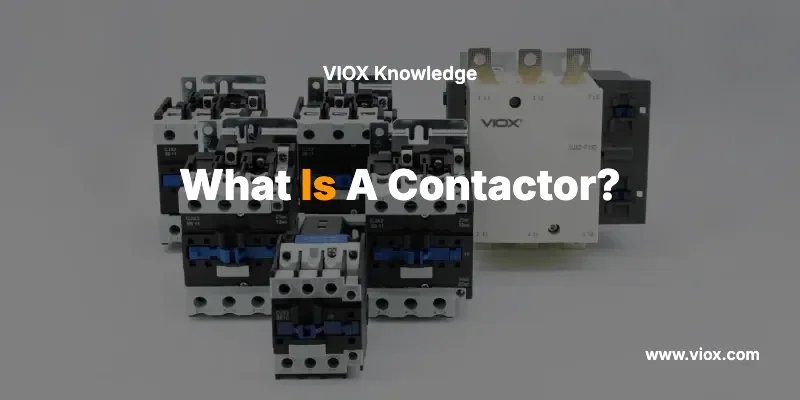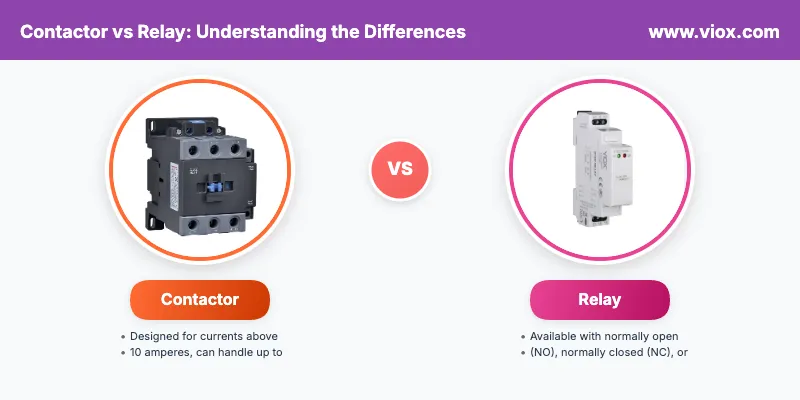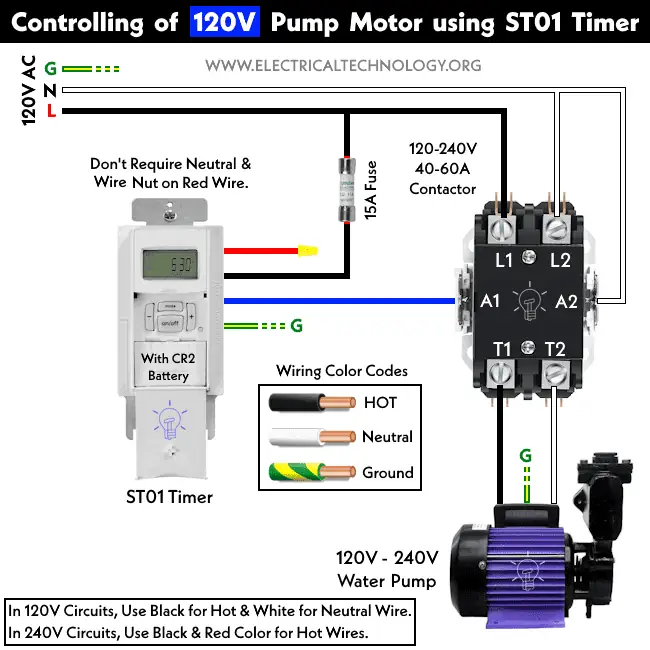소개
전기 접촉기는 고전력 전기 회로를 안전하고 효율적으로 제어하도록 설계된 특수 스위칭 장치입니다. 일반 스위치와 달리 접촉기는 전자기 원리를 사용하여 전기 연결을 개폐하므로 산업 자동화, 모터 제어 및 상업용 전기 시스템에 필수적인 부품입니다.
전기 시스템 관련 엔지니어, 기술자, 시설 관리자 등 누구에게나 접촉기의 정의와 작동 원리를 이해하는 것은 매우 중요합니다. 이 종합 가이드에서는 전기 접촉기, 그 응용 분야, 그리고 현대 전기 설비에 필수적인 요소에 대해 자세히 설명합니다.
접촉기란 무엇인가?

A 접촉기 전자기 코일을 사용하여 전기 접점의 개폐를 제어하는 전기기계식 스위칭 장치로, 고전력 회로의 안전한 제어를 가능하게 합니다. 이 장치는 전기적으로 작동하는 스위치 역할을 하며, 저전압 제어 회로가 고전압, 고전류 전기 부하를 안전하게 관리할 수 있도록 합니다.
접촉기의 주요 특징:
- 원격 조작: 저전압 신호를 사용하여 원격으로 제어할 수 있습니다.
- 높은 전류 용량: 상당한 전기 부하(일반적으로 10암페어 이상)를 처리하도록 설계되었습니다.
- 빈번한 전환: 성능 저하 없이 수천 번의 켜짐/꺼짐 주기를 위해 제작됨
- 안전 격리: 제어 회로와 전원 회로 사이에 전기적 분리를 제공합니다.
- 전자기 작동: 안정적인 접촉 작동을 위해 자기력을 사용합니다.
접촉기는 어떻게 작동하나요?
접촉기의 작동 원리는 전자기적 인력과 스프링 복귀 메커니즘을 기반으로 합니다.
단계별 작업:
- 활력화: 접촉기 코일에 전압(일반적으로 24V, 120V 또는 240V)이 인가되면 자기장이 생성됩니다.
- 자기적 매력: 자기장은 가동 철심(전기자)을 고정 전자기 코어 쪽으로 끌어당깁니다.
- 접촉 폐쇄: 전기자 운동은 이동 접점을 고정 접점에 밀어 넣어 회로를 완성합니다.
- 전류 흐름: 이제 전류가 주 접점을 통해 흐르면서 연결된 부하에 전원을 공급할 수 있습니다.
- 무전원화: 코일 전원이 제거되면 자기장이 붕괴됩니다.
- 봄이 돌아오다: 스프링 힘은 전기자를 뒤로 당겨 접점을 열고 전류 흐름을 차단합니다.
전자기 부품:
코일/전자석: 접촉기의 핵심으로 전원이 공급되면 자기장을 생성합니다.
전기자: 자기장에 반응하는 가동철심
연락처: 전기적 연결을 만들거나 끊는 전도성 요소
스프링스: 코일에 전원이 공급되지 않을 때 접점을 개방하기 위한 복귀력을 제공합니다.
접촉기 유형
AC 접촉기
AC 접촉기는 교류 응용 분야에 맞게 특별히 설계되었으며 상업 및 산업 현장에서 가장 일반적으로 사용되는 유형입니다.
주요 기능:
- 적층 코어 구조: 와전류 손실을 줄이기 위해 실리콘강 적층을 사용합니다.
- 아크 억제: 아크 슈트와 자기 분사 기능을 통합하여 아크를 빠르게 소멸시킵니다.
- 3상 기능: 일반적으로 3상 모터 회로를 제어하도록 설계됨
- 전압 등급: 120V ~ 1000V+까지 사용 가능
공통 애플리케이션:
- 전기 모터 제어(펌프, 팬, 압축기)
- HVAC 시스템 스위칭
- 조명 제어 시스템
- 산업 기계 자동화
DC 접촉기
DC 접촉기는 직류 부하를 처리하고 DC 스위칭의 고유한 과제를 관리하기 위한 특수한 설계 요소를 갖추고 있습니다.
주요 기능:
- 견고한 강철 코어: 와전류가 문제가 되지 않으므로 견고한 강자성 재료를 사용합니다.
- 향상된 아크 억제: 연속 전류로 인해 더욱 견고한 아크 소멸 방법이 필요합니다.
- 자기 폭발: 종종 접점에서 아크를 멀리 보내기 위해 자기식 분출 코일이 포함됩니다.
- 더 높은 접촉 간격: 안정적인 아크 소멸을 보장하기 위한 더 넓은 분리 거리
공통 애플리케이션:
- 태양광 발전 시스템 및 배터리 뱅크
- DC 모터 제어(엘리베이터, 크레인)
- 전기 자동차 충전 시스템
- 철도 및 교통 응용 프로그램
특수 접촉기 유형
- 접촉기 반전: 모터 회전 방향을 안전하게 역전시키는 이중 접점 세트 기능
- 조명 접촉기: 에너지 효율을 위한 래칭 메커니즘을 갖춘 저항성 부하에 최적화됨
- 커패시터 접촉기: 역률 보정 커패시터 스위칭용으로 설계됨
- 진공 접촉기: 중전압 및 고전압 응용 분야에 진공 밀봉 접점을 사용합니다.
접촉기 대 릴레이: 차이점 이해
접촉기와 릴레이는 유사한 전자기 원리로 작동하지만, 서로 다른 목적을 갖고 있으며 뚜렷한 특성을 가지고 있습니다.
부하 용량
- 접촉기: 10암페어 이상의 전류에 맞게 설계되었으며 최대 수천 암페어까지 처리할 수 있습니다.
- 릴레이: 일반적으로 10암페어 이하의 전류에 대해 정격이 지정됨
연락처 구성
- 접촉기: 주로 전원이 공급되면 닫히는 일반적으로 열려 있는(NO) 접점을 사용합니다.
- 릴레이: 일반적으로 개방형(NO), 일반적으로 폐쇄형(NC) 또는 전환형 접점으로 사용 가능
물리적 크기 및 구조
- 접촉기: 고전력 부하를 처리할 수 있는 더 크고 견고한 구조
- 릴레이: 제어 회로 응용 분야에 적합한 컴팩트한 디자인
아크 억제
- 접촉기: 고전류 스위칭을 위한 정교한 아크 억제 메커니즘 포함
- 릴레이: 낮은 전류를 처리하므로 아크 억제가 최소화됩니다.
애플리케이션
- 접촉기: 모터 제어, 조명 시스템, 중공업 부하
- 릴레이: 신호 스위칭, 제어 로직, 저전력 장치 제어
안전 기능
- 접촉기: 종종 과부하 보호 및 추가 안전 접점이 포함됩니다.
- 릴레이: 추가 보호 기능 없이 기본 스위칭 기능 제공
접촉기 응용 프로그램 및 사용
모터 제어 시스템
크레딧 제공처 전기기술
접촉기는 모터 제어 애플리케이션에 필수적이며 다음을 제공합니다.
- 안전한 시동 및 정지 전기 모터의
- 과부하 보호 열 과부하 릴레이와 결합 시
- 원격 조작 제어판이나 자동화 시스템에서
- 비상 정지 기능 안전 규정 준수
산업 자동화
제조 및 공정 제어에서:
- 컨베이어 시스템 제어
- 펌프 및 압축기 작동
- 자재 취급 장비
- 공정 라인 자동화
상업용 건물 시스템
- HVAC 제어: 난방, 환기 및 공조 시스템 관리
- 조명 관리: 사무실 건물, 소매 공간의 대형 조명 설비 제어
- 전력 분배: 전기 패널 및 배전반 스위칭
발전 및 배전
- 발전기 제어 시스템
- 커패시터 뱅크 스위칭 역률 보정을 위해
- 변전소 자동화
- 재생 에너지 시스템 (태양광 및 풍력 발전)
접촉기 사양 및 선택
전기 등급
- 전압 평가: 접촉기가 안전하게 처리할 수 있는 최대 전압
- 현재 평가: 최대 연속 전류 용량
- 마력 등급: 특정 전압에서의 모터 부하 용량
- 활용 범주: 부하 유형을 정의합니다(저항형의 경우 AC-1, 모터의 경우 AC-3)
코일 사양
- 코일 전압: 전자기 코일의 작동 전압(24V, 120V, 240V 등)
- 코일 유형: AC 또는 DC 작동
- 전력 소비량: 코일 전원을 유지하는 데 필요한 에너지
기계적 특성
- 접촉 재료: 은 합금, 산화은 또는 기타 특수 소재
- 폴 수: 단극, 2극, 3극 또는 4극 구성
- 보조 연락처: 제어 회로 기능을 위한 추가 접점
- 마운팅 유형: DIN 레일, 패널 마운트 또는 기타 설치 방법
환경적 고려 사항
- 온도 범위: 작동 온도 한계
- 인클로저 정격: 먼지, 습기 및 환경적 위험으로부터 보호
- 진동 저항: 기계적 응력을 견디는 능력
- 고도 등급: 다양한 고도에서의 성능
설치 및 배선
일반적인 접촉기 연결
- 노선 터미널(L1, L2, L3): 입력 전원 공급 장치에 연결
- 부하 단자(T1, T2, T3): 전기 부하(모터, 조명 등)에 연결합니다.
- 코일 단자(A1, A2): 제어 회로 전압에 연결
- 보조 연락처: 신호, 연동 또는 피드백 회로에 사용됨
제어 회로 통합
접촉기는 일반적으로 다음과 같은 제어 시스템에 통합됩니다.
- 시작/정지 푸시 버튼 수동 작동용
- 과부하 릴레이 모터 보호를 위해
- PLC 출력 자동 제어를 위해
- 타이머 릴레이 순차적 작업의 경우
안전 고려 사항
- 적절한 접지 모든 금속 부품
- 아크 플래시 보호 전원이 공급되는 장비에서 작업할 때
- 잠금/태그아웃 절차 유지 보수 중
- 적절한 여유 공간 안전한 작동 및 유지 관리를 위해
유지 관리 및 문제 해결
정기 유지 관리 작업
- 육안 검사: 과열, 부식 또는 물리적 손상의 징후를 확인하세요
- 접촉 검사: 접점에 구멍, 타는 것 또는 과도한 마모가 있는지 검사합니다.
- 코일 테스트: 적절한 코일 저항 및 절연을 확인하세요.
- 기계 작동: 원활한 전기자 움직임과 적절한 스프링 작동을 보장합니다.
일반적인 문제 및 해결책
- 연락처가 닫히지 않음: 코일 전압, 기계적 장애물 또는 마모된 스프링을 확인하세요.
- 접점 용접 셧: 일반적으로 과전류 조건 또는 부적절한 아크 억제를 나타냅니다.
- 채터링 작업: 코일 전압이 낮거나 기계적 문제가 있을 수 있습니다.
- 과열: 연결 불량, 과부하 또는 환기 부족으로 인해 발생할 수 있습니다.
교체 지침
다음과 같은 경우 접촉기를 교체하세요.
- 접점이 과도하게 마모되거나 손상됨
- 코일 저항이 제조업체 사양을 벗어났습니다.
- 기계 작동이 느리거나 불규칙해집니다.
- 아크 억제 부품이 손상되었습니다.
미래 트렌드와 기술
스마트 접촉기
현대의 접촉기에는 점점 더 디지털 기술이 통합됩니다.
- 내장된 진단 기능 예측 유지 관리를 위해
- 커뮤니케이션 능력 시스템 통합을 위해
- 에너지 모니터링 특징
- 원격 모니터링 IoT 연결을 통해
솔리드 스테이트 대안
전기기계식 접촉기가 여전히 우세한 반면, 솔리드 스테이트 스위칭 장치는 다음과 같은 장점을 제공합니다.
- 더 빠른 전환 속도
- 기계적 마모 없음
- 조용한 작동
- 정밀한 제어 기능
결론
접촉기가 무엇이고 어떻게 작동하는지 이해하는 것은 전기 시스템을 다루는 모든 사람에게 필수적입니다. 이 신뢰성 높은 전자기 스위칭 장치는 간단한 모터 스타터부터 복잡한 산업 자동화 시스템에 이르기까지 수많은 응용 분야에서 고전력 전기 부하를 안전하고 효율적으로 제어합니다.
새로운 설비에 대한 장비를 지정하거나, 기존 시스템의 문제를 해결하거나, 유지 관리 활동을 계획하는 경우, 접촉기 작동, 유형 및 응용 분야에 대한 철저한 이해는 안전하고 신뢰할 수 있는 전기 시스템 성능을 보장하는 데 도움이 됩니다.
접촉기 적용의 성공 비결은 부하 요구 사항, 환경 조건 및 제어 시스템 통합 요구 사항을 기반으로 적절한 접촉기를 선택하는 것입니다. 접촉기는 적절한 설치, 유지보수 및 작동을 통해 까다로운 전력 제어 분야에서 수년간 안정적인 서비스를 제공합니다.
주요 요점:
- 접촉기는 고전력 전기 회로 제어를 위해 설계된 전자기 스위치입니다.
- 접촉기는 주로 전류 처리 용량과 구조 면에서 릴레이와 다릅니다.
- AC 및 DC 접촉기는 각각의 전류 유형을 처리하기 위해 서로 다른 설계 기능을 가지고 있습니다.
- 안전하고 안정적인 작동을 위해서는 적절한 선택, 설치 및 유지 관리가 중요합니다.
- 접촉기는 모터 제어, 조명 시스템 및 산업 자동화에 필수적인 구성 요소입니다.
접촉기에 대한 자주 묻는 질문
접촉기와 릴레이의 차이점은 무엇인가요?
주요 차이점은 하중 용량과 구조입니다. 접촉기는 10암페어 이상의 전류에 적합하도록 설계되었으며, 아크 억제 기능을 갖춘 견고한 구조를 갖추고 있습니다. 계전기는 일반적으로 10암페어 이하의 전류를 처리하며 제어 회로에 사용됩니다. 접촉기는 주로 상시 개방 접점을 사용하지만, 계전기는 상시 개방, 상시 폐쇄 또는 전환 접점을 가질 수 있습니다.
접촉기가 고장나거나 타버리는 이유는 무엇입니까?
접촉기 고장의 일반적인 원인은 다음과 같습니다.
– 정격 용량을 초과한 과부하
– 과도한 아크로 인한 접촉 용접
– 전압 변동으로 인한 코일 과열
– 먼지, 습기 또는 부식성 가스와 같은 환경 요인
– 과도한 사이클링으로 인한 기계적 마모
– 전압 강하를 유발하는 전기 연결 불량
작동하지 않는 접촉기의 문제를 어떻게 해결하나요?
다음과 같은 체계적인 접근 방식을 따르세요.
1. 코일 단자(A1, A2)의 제어 전압을 확인하세요.
2. 멀티미터로 코일 저항을 테스트하세요
3. 접점을 검사하여 손상, 구멍 또는 용접 여부를 확인합니다.
4. 기계적 작동 확인 - 적절한 "클릭" 소리를 들어보세요.
5. 보조 접점의 연속성을 확인하십시오.
6. 과부하 릴레이 설정 및 작동을 검토합니다.
모터 제어를 위한 접촉기를 어떻게 배선하나요?
기본 모터 접촉기 배선에는 다음이 포함됩니다.
1. 전원 연결: L1, L2, L3을 입력 전원 공급 장치에 연결합니다.
2. 부하 연결: T1, T2, T3를 모터 단자에 연결합니다.
3. 제어 회로: 전압(일반적으로 24V, 120V 또는 240V)을 제어하기 위해 A1, A2를 연결합니다.
4. 시작/정지 버튼: 코일 회로와 직렬로 연결
5. 보조접점 : 회로 유지 및 상태 표시에 사용
6. 과부하 릴레이: 모터 보호를 위해 직렬로 연결
접촉기에서 덜거덕거림이나 윙윙거리는 소리가 나는 원인은 무엇입니까?
접촉기 떨림은 다음을 나타냅니다.
– 제어 전압이 낮아 자기력이 부족함
– 느슨한 전기 연결로 인해 전압 강하 발생
– 손상된 셰이딩 코일(AC 접촉기)
– 적절한 접촉 폐쇄를 방해하는 기계적 장애물
– 공급 시스템의 전압 변동
– 마모된 접촉면으로 인해 연결 불량 발생
DC 애플리케이션에 AC 접촉기를 사용할 수 있나요?
일반적으로 수정 없이 사용하는 것은 권장하지 않습니다. AC 접촉기는 DC 전류가 AC처럼 자연적으로 제로 크로스되지 않기 때문에 DC 애플리케이션에 적합한 아크 억제 기능이 부족합니다. 절대적으로 필요한 경우, 접촉기의 정격을 크게 낮추고(일반적으로 AC 정격의 50% 이하로) 추가적인 아크 억제 기능을 추가해야 합니다. DC 애플리케이션에는 항상 DC 정격 접촉기를 사용하는 것이 좋습니다.
접촉기가 불량한지 어떻게 테스트하나요?
주요 테스트는 다음과 같습니다.
1. 코일 저항 테스트: A1-A2 단자 간 저항을 측정합니다.
2. 접점 연속성 테스트: 전원이 공급될 때 주 접점의 저항을 확인합니다(0옴에 가까워야 함).
3. 절연 테스트: 전원이 꺼졌을 때 코일과 접점 사이에 연속성이 없는지 확인하십시오.
4. 기계적 작동 테스트: 적절한 클릭음을 듣고 접촉 움직임을 관찰합니다.
5. 전압 테스트: 작동 중 실제 코일 전압을 측정합니다.
접촉기에는 어떤 유형이 있나요?
주요 접촉기 유형은 다음과 같습니다.
– AC 접촉기: 교류 응용 분야(가장 일반적)
– DC 접촉기: 직류 부하용으로 설계됨
– 역전 접촉기: 모터 방향 반전 허용
– 조명 접촉기: 저항성 조명 부하에 최적화됨
– 커패시터 접촉기: 역률 보정 커패시터 스위칭용으로 설계됨
– 진공 접촉기: 중전압 및 고전압 응용 분야용
왜 접촉기에 전원이 들어오지 않나요?
일반적인 원인은 다음과 같습니다.
– 코일 단자에 제어 전압 없음
– 제어 회로의 퓨즈가 끊어짐
– 제어 배선의 개방 회로
–잘못된 코일(점화 또는 손상)
– 전기자 이동을 방해하는 기계적 방해
– 적용 전압에 대한 잘못된 코일 전압 정격
– 전압 강하를 유발하는 전기 연결 불량
접촉기는 얼마나 자주 유지관리해야 합니까?
권장 유지 관리 일정:
– 월별: 손상, 과열 또는 오염에 대한 시각적 검사
– 분기별: 접점 청소 및 연결 확인
– 매년: 코일 저항 및 접촉 상태를 포함한 종합 테스트
– 필요에 따라: 접점에 과도한 마모, 구멍 또는 타는 현상이 나타나면 교체하십시오.
– 오류 조건 후: 과부하 또는 단락 이벤트가 발생한 후 즉시 검사하십시오.
과부하 릴레이 없이도 접촉기가 작동할 수 있나요?
네, 하지만 모터 용도로는 권장되지 않습니다. 접촉기는 독립적으로 작동할 수 있지만, 과부하 계전기는 과전류 발생 시 필수적인 모터 보호 기능을 제공합니다. 조명이나 난방 부하의 경우 과부하 보호가 그다지 중요하지 않을 수 있지만, 모터 애플리케이션에는 손상을 방지하고 안전을 보장하기 위해 항상 적절한 과부하 보호 기능을 포함해야 합니다.
접촉기 코일에는 어떤 전압을 사용해야 합니까?
일반적인 코일 전압은 다음과 같습니다:
– 24V DC/AC: 산업용 제어 시스템에서 가장 일반적입니다.
– 120V AC: 북미 주거/상업용 애플리케이션의 표준
– 240V AC: 고전압 제어 시스템에 사용됨
– 480V AC: 고전압 제어가 필요한 산업용 애플리케이션
사용 가능한 제어 전원 공급 장치와 안전 요구 사항을 고려하여 코일 전압을 선택하십시오. 낮은 전압(24V)이 작업자 인터페이스에 더 안전합니다.




